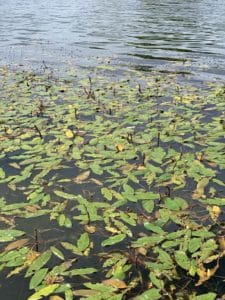
American Pondweed
Pond owners often perceive any type of aquatic growth as unwelcome. However, there are several aquatic plants that are favorable to the health of a pond. Whether it is considered a desirable “plant” or an invasive “weed” is often determined by the size and depth of the pond. This is because both desirable and undesirable plants tend to grow in shallow water. If you have a small, shallow pond, your desirable plants can potentially take over the entire pond in a single growing season. On the other hand, if your pond has adequate depth, most aquatic vegetation will limit its growth to those areas around the shoreline. There are 3 major categories of aquatic plants: Emergent, Submersed, and Floating.
Emergent aquatic plants – most are beneficial
Emergent plants are rooted but extend above the water surface. These plants are most often found around the edge of the pond. Most emergent plants are beneficial because they aid in stabilizing shorelines, reducing nutrients, and providing habitat for both forage and gamefish species. Since most emergent plants only grow in very shallow water, they take up area that would otherwise be occupied by unsightly algae. And lastly, emergent plants in moderation are excellent for adding natural character to urban ponds. Some examples of desirable emergent plants include water willow, American pondweed, arrowhead, pickerelweed, iris, and water primrose (in moderation). Undesirable species include cattails, alligator weed, and American lotus.
Submersed aquatic plants – keep them under control
Submersed plants are almost always considered undesirable in small ponds. These plants are rooted and rise to the water surface, but usually do not break it. The depth to which submersed plants can grow is determined by water clarity and degree of sunlight penetration. Submersed plants interfere with angling and can clog fountains, aerators, and irrigation pumps. If quality fishing is of high priority, excessive submersed weeds can encourage poor growth of both bass and forage species. Submersed plants are especially a concern during the heat of the summer. Too much growth reduces nighttime oxygen levels and can result in fish kills. A general rule of thumb is that any more than 20% coverage of submersed plant growth is detrimental to a pond. The most common submersed plants in the Dallas/Fort Worth area are bushy pondweed, coontail, watermilfoil, and sago pondweed.

Water Primrose
Floating plants – the most undesirable
Floating plants are the smallest group of aquatic plants. These plants are un-rooted and float freely on the surface. All floating species are considered undesirable because their growth is not limited by water depth. As a result, they can quickly cover the entire pond surface. This completely blocks out sunlight penetration and often results in a catastrophic fish kill due to oxygen depletion. The most common floating plants in this area are duckweed, watermeal, and mosquito fern.
Exotic plants – keep them out
Lastly, all non-native species are considered undesirable. Non-native plant species are highly invasive and outcompete our native pond vegetation. Common exotic plant species found in Texas include alligator weed, Eurasian watermilfoil, hydrilla, Salvinia, and water hyacinth. Measures should always be taken to control the spread of these particular plants.
If you think you have a “weed” problem………..call Magnolia Fisheries today for the solution!
